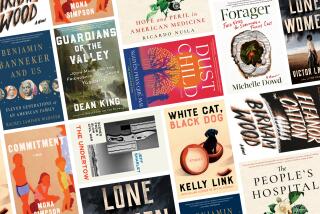DISCOVERIES
- Share via
Welcome to Lizard
Motel
Children, Stories, and the Mystery
of Making Things Up
Barbara Feinberg
Beacon: 270 pp., $23
Two lizards, brothers, fly into the sun. Their tails catch fire. One expert decided that this story’s first-grade author needed to write about the things he and his brother “really” did together, a response that worries Barbara Feinberg, whose “Welcome to Lizard Motel” tells of her story-writing workshop for children. She has noticed that her 12-year-old son has become anxious about reading, and that the books he is assigned -- “The Face on the Milk Carton” or “The Pigman,” about a child’s uncle “so demented by grief that he hallucinates his dead wife throughout the whole book” -- fall under the heading of reality fiction designed to help children better deal with life’s problems. She misses books like “The Adventures of Huckleberry Finn” that were full of fantasy and presented a safe world in which a child could have adventures. “... I went and set on the bank ... and counted the stars and drift logs and rafts that come down, and then went to bed,” she quotes from the classic.
Throughout “Lizard Motel,” Feinberg stretches to remember how it felt to be a child reading, “to feel as if you were a citizen in two places at once: the everyday world and then ‘over there,’ where everything was vivid in a different way -- colors deeper.” To research this book, Feinberg spent long hours in her local library, falling asleep on the floor, trying to understand how young readers “draw courage” from books. She finds that most award-winning children’s books feature kids who gain maturity by testing “the soul and the self” through rites of passage.
When her 7-year-old daughter faces surgery to remove a tumor from her ear, the author finds solace in stories written by her young students over the years. For one exercise, students created boxes, small worlds in which to set their stories. One child made a “Lizard Motel” with a “Poison Room,” a “Weapons Room” (complete with corkscrew) and a “Jewel Room” filled with glitter. His story -- written on a sheet of paper, folded neatly and left in a jewel room drawer -- contains a child’s vision of death, in which “nothing is ever truly lost, just gone.” It makes a reader feel safer, less anxious.
*
I Am a Pencil
A Teacher, His Kids, and
Their World of Stories
Sam Swope
Henry Holt: 298 pp., $25
CHILDREN’s author Sam Swope found himself in a writing rut, so he accepted a job running a writing workshop for third-, fourth- and fifth-graders in Queens, N.Y. His students were from 21 different countries and spoke 11 different languages besides English. They came from a variety of religious backgrounds and living situations. Swope didn’t expect to fall in love with these children but he did, and hard. The raw power of their writing, once they trusted him, is astonishing, he explains in “I Am a Pencil.”
Writes Miguel, the child of Pentecostal parents who is growing up in a troubled home: “It grows big / but he / is small / although / big things / are happening inside.” His writing grows increasingly violent as his home situation deteriorates.
“I’m a puzzle / because I don’t say much / and I’m hard to figure out,” writes Su Jung, one of Swope’s most challenging students. Her mother left her father and returned to Korea while Su Jung was in the third grade. Her stories, full of dark plains and women pregnant with the sun, are nothing short of mythical and yet she often refuses to speak in class or in private consultations.
Swope visits their homes, listens to their parents’ problems, even researches middle schools for them. The stories he encourages them to write reveal their sense (or lack) of self-worth, their feelings about the world, their ability to trust the adults around them. The safer they feel, he tells us, the fewer doors they slam shut. The fewer doors they shut, the more creative they can be. The more creative they are, the more they can use their imaginations to create and step into the worlds they hope to inhabit. If only Swope’s book were a lesson plan we could follow. Alas, it is more like a fortuitous chemical reaction, a place in time with a group of children and a teacher whose mutual needs were met.
More to Read
Sign up for our Book Club newsletter
Get the latest news, events and more from the Los Angeles Times Book Club, and help us get L.A. reading and talking.
You may occasionally receive promotional content from the Los Angeles Times.







